|
Special Features





Image Libraries


|
|
Blog
Mayor Bowser's latest DC budget proposal includes $165 million to replace the Hopscotch Bridge. Once a new bridge is open, an eyesore will become a prime public space, and long-awaited expansions of Union Station and DC Streetcar can finally happen.

Rendering of the new Hopscotch Bridge, surrounded by new development behind Union Station. Image by Akridge.
Today, Hopscotch Bridge carries H Street over the railroad tracks behind Union Station. In order to make room for trains to pass below, the bridge rises high above H Street's normal elevation. With solid walls and the Union Station parking garage on either side, the bridge is a three block long stretch of desolation, amid an otherwise vibrant part of the city.
Replacing the bridge will change that.
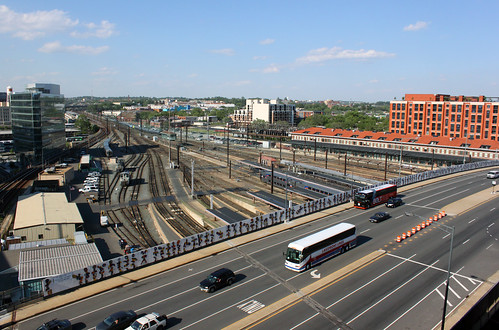
Existing Hopscotch Bridge. Image by Bossi licensed under Creative Commons.
A new bridge, designed specifically to accommodate buildings on either side, will make it possible to develop the air rights above Union Station's railyard, and to replace the parking garage with a new train hall. What was desolate will become a major new public space, with landmark architecture, a mix of uses, and a more open, European-style train hall.
That development is called Burnham Place. It's a very ambitious plan.

Proposed H Street entrance to Union Station, as part of Burnham Place. Image by Akridge.
Streetcar can go downtown
Building a new Hopscotch Bridge also opens to door to finally extending the H Street Streetcar to downtown Washington and Georgetown. The streetcar doesn't specifically need a new bridge, but timing is an issue. DDOT doesn't want to extend the streetcar now only to rip up tracks and suspend service in a couple of years when the bridge is torn down and replaced anyway.
As it is, tearing down and replacing the existing bridge will mean temporarily removing the streetcar stop atop the bridge. That's bad enough, but it would be a much worse situation with streetcars running downtown.
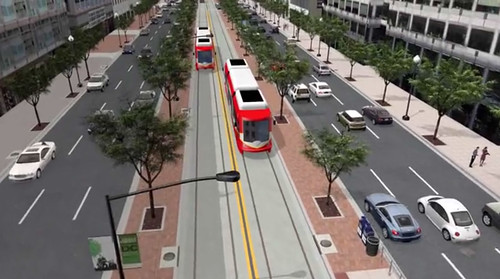
When it runs downtown, DC Streetcar will have a dedicated transitway. Image by DDOT.
Budget details
Mayor Bowser's proposal would fund $165 million in 2019 and 2020. The DC Council will have to approve the budget before it becomes law. Even if it does, another $40 million would still be needed before construction could begin. That money would either come from other sources, or a future year's budget.
Once funding is fully in place and DDOT completes the final design, construction should take about two years.
 Comment on this at the version cross-posted to Greater Greater Washington. Comment on this at the version cross-posted to Greater Greater Washington.
Average Rating: 4.5 out of 5 based on 299 user reviews.
April 4th, 2017 | Permalink
Tags: development, funding, government, master planning, roads/cars, streetcar, transportation

Last night, US House majority leader Eric Cantor lost the Republican primary to a tea party challenger who painted Cantor as too willing to compromise with Democrats. Cantor’s loss makes this summer’s looming congressional fight over transportation funding all the more unpredictable.
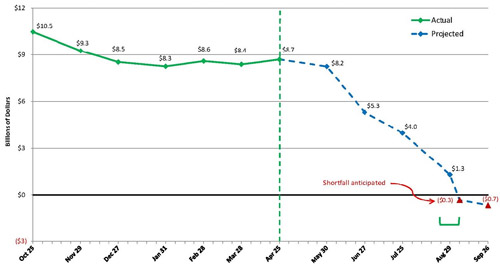
US Highway Trust Fund balance. If Congress doesn’t act soon, money will run out. Image from USDOT.
MAP-21, the federal transportation funding bill, expires in October. But USDOT will begin running out of money in August. Without a bipartisan bill to add new money, federal transportation funding will trickle to a halt.
Transportation wasn’t a major issue in Cantor’s election, but immigration reform was. Cantor mostly opposed immigration reform, but he briefly contemplated compromise, giving his more conservative opponent David Brat an opening to attack.
Some pundits fear that will push every other House Republican away from compromise in general, and grind whatever progress Congress was making on anything to a halt.
From an immigration perspective that probably makes little difference; House Republicans were not going to compromise anyway. But it could make a huge difference for transportation.
Transportation funding was a non-partisan issue in the 20th Century. Every 6 years Congress would pass a transportation bill with broad support from both parties. But in recent years, amid declining gas tax revenue and increasing need for supplemental funding, transportation has become a partisan spark.
Congress seemed primed to act, but now it’s an open question
Up until Cantor’s defeat, the general assumption in the transportation world has been that Congress would do something this summer. “Something” might mean a long term solution like a new bill and new taxes. Or it might mean a band-aid, like an extension of MAP-21 with an infusion of federal general fund dollars. Either way, Congress appeared to be making some progress.
But now? House Republicans might very well cease all legislative activity, and hope to ride out the rest of election season without upsetting their conservative base.
Polls show that raising money for transportation is popular, and voters rarely punish officials for doing so. But that may not matter to Republicans concerned about attacks from the extreme right.
While in Congress, Cantor fought against progressive transportation funding. But in this case his personal vote, and even his leadership on the specifics, might be less important than the simple fact that he was probably willing to advance a bill.
On the other hand, maybe the Republican establishment will take this as a call to arms, and moderate legislators will become more powerful. But that seems unlikely the day after the biggest tea party victory of the season.
 Cross-posted at Greater Greater Washington. Cross-posted at Greater Greater Washington.
Average Rating: 4.8 out of 5 based on 286 user reviews.
June 11th, 2014 | Permalink
Tags: funding, government, people, transportation

|
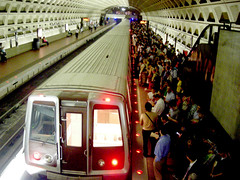
Packed Metro platform. |
Following a week of terrible Red Line Metro service, WMATA is offering refunds to riders who were inconvenienced. That’s a nice gesture, and perhaps it’s appropriate as a special measure when the same customers are hit with so many unexpected delays in such a short time. But in general, refunds are not the answer to Metro’s woes.
Yes, customers deserve to receive the service they’ve paid for, and yes, it’s satisfying to hold WMATA financially accountable when it doesn’t meet expectations. Those are the arguments in favor of refunds, and admittedly they’re compelling.
But if WMATA actually gave refunds every time there was a breakdown (which as we all know is unfortunately frequently), what would the side effects be? As always, follow the money.
For one, it would slow Metro’s reconstruction efforts, by diverting funding away from maintenance work. This painful period of single tracking and service interruptions would likely last years longer.
That’s bad enough, but consider WMATA’s likely response the next time there’s an unexpected rush hour breakdown. Instead of allowing thousands of passengers to continue entering the system and paying fares after the breakdown starts, only to be due refunds later, Metro would probably start to simply shut down entire lines. After all, you can’t demand a refund if you were never allowed to enter in the first place.
So on days like Wednesday, instead of bad service Metro riders might be left with no service at all. I don’t think that’s better.
At some point WMATA does need to be held accountable, so perhaps it was appropriate to offer refunds this week. But Washingtonians should neither demand nor expect a refund every time we have to wait for single tracking. Ultimately, improving Metro service back to the point where these delays don’t happen so often is what we really want. Frequent refunds wouldn’t help that goal.
 Cross-posted at Greater Greater Washington. Cross-posted at Greater Greater Washington.
Average Rating: 4.5 out of 5 based on 287 user reviews.
November 15th, 2013 | Permalink
Tags: funding, metrorail, transportation

|
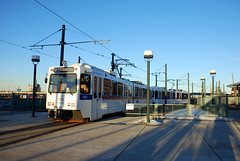
Denver is expanding its light rail system using private partners. |
Maryland Governor O’Malley is expected to announce today that the federal government has approved the Purple Line’s planning, and that Maryland will seek a private company to help pay for construction.
The idea is that a private company would pool its money together with state and federal funding to construct the Purple Line. The same company would then operate the line. In exchange, they would keep the fares, and Maryland would pay an annual contract fee.
With limited federal funds available, this type of public-private partnership is becoming common nationwide. DC is considering it for streetcars, but Denver offers a more instructive example.
In 2004, voters in Colorado passed a referendum for 122 miles of new rail transit in the Denver area. But the funding approved as part of that vote wasn’t adequate to build everything, so the transit agency had to find an alternate strategy. They’ve since approved two public-private partnerships, and are in the process of contracting a third.
Denver’s first partnership was for the Eagle P3 project, which is building 40 miles of electric commuter rail to the Denver suburbs and airport, at a cost of about $2 billion. The partnership is proceeding smoothly, with construction well underway and completion expected in 2016.
The second partnership is for a 10-mile-long suburban light rail extension. It began construction last year and is also expected to open in 2016.
The third will be for the 18-mile North commuter line. The transit agency put out a Request For Proposals in June, and is expected to select a partner company this fall.
All in all, Denver has or will soon have private partnerships to build almost 70 miles of new rail.
These deals do come with a cost. Typically the annual fee the state has to pay the partner is higher than the typical operating subsidy would be. So in essence, the operating cost is higher. But in exchange, the partner builds the line more quickly and sometimes more cheaply than the government could on its own.
Update: As expected, O’Malley announced the plan to use a partnership this afternoon. He also announced $680 million in state funds for the Purple Line, plus millions more for the Corridor Cities Transitway, Montgomery County Ride-On, and road projects.
Average Rating: 4.9 out of 5 based on 199 user reviews.
August 5th, 2013 | Permalink
Tags: commuterrail, funding, government, lightrail, transportation

|

Almost $20 million will go to new VRE railcars. |
For years, leaders in Northern Virginia have been asking Richmond to let Northern Virginia raise its own money to spend on its own transportation priorities. They are finally getting the chance.
When the Virginia General Assembly passed a broad new transportation funding bill earlier this year, it included a section for Northern Virginia to raise and allocate hundreds of millions of dollars per year. Those new taxes began rolling in on July 1, with the beginning of Virginia fiscal year 2014.
On Wednesday night, the Northern Virginia Transportation Authority (NVTA) officially approved its first set of projects. The authority allocated about $210 million, split roughly evenly between transit and roads.
The largest projects include the Silver Line’s Innovation Center Metro station, new VRE railcars, and widenings along Route 28.
NVTA also approved a bond validation lawsuit that will preemptively ask Virginia courts to rule on NVTA’s legality. That process should take 6-9 months, and NVTA will have to wait until it’s over to actually start spending money. Taking the suit to court now means NVTA won’t have to spend years fending off other legal challenges.
The project list is shown below. For more details, see the project description sheets on NVTA’s website.
| Project |
Funding
in millions |
Location |
| Transit and multimodal projects |
| Innovation Center Metro station |
$41 |
Fairfax Co. |
| VRE railcars |
$19.8 |
Regional |
| VRE Lorton station 2nd platform |
$7.9 |
Fairfax Co. |
| WMATA buses |
$7 |
Regional |
| WMATA Orange Line traction power upgrades for 8-car trains |
$5 |
Regional |
| DASH buses |
$3.3 |
Alexandria |
| Potomac Yard Metro station environmental study |
$2 |
Alexandria |
| Crystal City multimodal center bus bays |
$1.5 |
Arlington |
| VRE Gainesville extension planning |
$1.5 |
Regional |
| VRE Alexandria station pedestrian tunnel & platform improvements |
$1.3 |
Alexandria |
| Herndon Metro station access improvements (road, bus, bike/ped) |
$1.1 |
Fairfax Co. |
| ART buses |
$1 |
Arlington |
| Leesburg park and ride |
$1 |
Loudoun |
| Loudoun County Transit buses |
$0.9 |
Loudoun |
| Route 7 Tysons-to-Alexandria transit alternatives analysis (phase 2) |
$0.8 |
Regional |
| Falls Church pedestrian access to transit |
$0.7 |
Falls Church |
| Duke Street transit signal priority |
$0.7 |
Alexandria |
| PRTC bus |
$0.6 |
Prince William |
| Alexandria bus shelters & real-time information |
$0.5 |
Alexandria |
| Van Buren pedestrian bridge |
$0.3 |
Falls Church |
| Falls Church bus shelters |
$0.2 |
Falls Church |
| Road projects |
| Rt 28 – Linton Hall to Fitzwater Dr |
$28 |
Prince William |
| Rt 28 – Dulles to Rt 50 |
$20 |
Fairfax Co. |
| Belmont Ridge Road north of Dulles Greenway |
$20 |
Loudoun |
| Columbia Pike multimodal improvements (roadway, sidewalk, utilities) |
$12 |
Arlington |
| Rt 28 – McLearen to Dulles |
$11.1 |
Fairfax Co. |
| Rt 28 – Loudoun “hot spots” |
$6.4 |
Loudoun |
| Chain Bridge Road widening |
$5 |
Fairfax City |
| Boundary Channel Dr interchange |
$4.3 |
Arlington |
| Rt 1 – Featherstone Rd to Mary’s Way |
$3 |
Prince William |
| Edwards Ferry Rd interchange |
$1 |
Loudoun |
| Herndon Parkway intersection with Van Buren St |
$0.5 |
Fairfax Co. |
| Herndon Parkway intersection with Sterling Rd |
$0.5 |
Fairfax Co. |
 Cross-posted at Greater Greater Washington. Cross-posted at Greater Greater Washington.
Average Rating: 4.5 out of 5 based on 234 user reviews.
July 26th, 2013 | Permalink
Tags: BRT, bus, commuterrail, funding, government, lightrail, metrorail, roads/cars, transportation

|
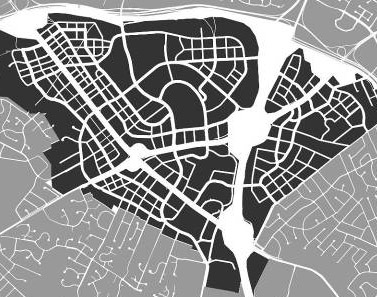
Tysons grid of streets, no. 2. |
Maryland and Virginia will both enact major new transportation funding bills this year. Neither bill says exactly which projects will be funded, but here are the top 10 projects in Maryland and Virginia that most deserve to get some of the funds.
Number 1: 8-car Metro trains. Metrorail is near capacity, especially in Virginia. More Metro railcars would mean more 8-car trains on the Orange, Blue, and Silver Lines.
Number 2: Tysons grid of streets. Tysons Corner has more office space than downtown Baltimore and Richmond put together. Converting it to a functional urban place is a huge priority.
Number 3: Purple Line. Bethesda, Silver Spring, Langley Park, College Park, New Carrollton. That’s a serious string of transit-friendly pearls. The Purple Line will be one of America’s best light rail lines on the day it opens.
Number 4: Baltimore Red Line. Baltimore has a subway line and a light rail line, but they don’t work together very well as a system. The Red Line will greatly improve the reach of Baltimore’s rail system.
Number 5: Silver Line Phase 2. The Silver Line extension from Reston to Dulles Airport and Loudoun County is one of the few projects that was earmarked in Virginia’s bill, to the tune of $300 million.
Number 6: Arlington streetcars. The Columbia Pike and Crystal City streetcars both have funding plans already, but could potentially be accelerated.
Number 7: Route 7 transit. Leesburg Pike is the next Rosslyn-Ballston corridor waiting to happen. Virginia is just beginning to study either a light rail or BRT line along it.
|

Corridor Cities Transitway, no. 8. |
Number 6: Corridor Cities Transitway. Gaithersburg has been waiting decades for a quality transit line to build around. BRT will finally connect the many new urbanist communities there, which are internally walkable but rely on cars for long-range connections.
Number 9: MARC enhancements. MARC is a decent commuter rail, but it could be so much more. Some day it could be more like New York’s Metro North or Philadelphia’s SEPTA regional rail, with hourly trains all day long, even on weekends.
Number 10: Alexandria BRT network. This will make nearly all of Alexandria accessible via high quality transit.
Honorable Mentions: Montgomery BRT network, Potomac Yard Metro station, Virginia Beach light rail, Southern Maryland light rail, VRE platform extensions.
 Cross-posted at Greater Greater Washington. Cross-posted at Greater Greater Washington.
Average Rating: 4.5 out of 5 based on 168 user reviews.
April 3rd, 2013 | Permalink
Tags: BRT, commuterrail, funding, government, lightrail, metrorail, roads/cars, streetcar, top10, transportation

|
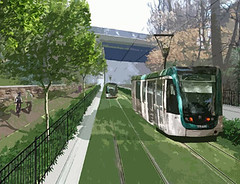
The Purple Line won’t happen without more money. Image from Maryland MTA. |
Yesterday, Maryland governor Martin O’Malley released his proposal to restructure Maryland’s gas taxes to raise $3.4 billion for transportation over 5 years. The plan is superficially similar to the recent Virginia transportation funding bill, but improves upon it in several ways.
Maryland needs new revenue this year. Without it, the Purple Line, the Corridor Cities Transitway, and the Baltimore Red Line could all stop moving forward.
The key to the bill is a new 2% wholesale tax on gasoline. Wholesale taxes differ from normal gas taxes in that the gas distributor pays them rather than the consumer. The distributor then usually passes the tax along to consumers via higher prices.
The plan partially offsets this wholesale tax by reducing the normal gas tax, from 23.5¢ per gallon to 18.5¢ per gallon. But the plan would also index the new lower gas tax to inflation, so it would increase slightly each year.
Taken together, overall tax revenue from gas would go up by about 2¢ per gallon as soon as the bill takes effect. In 2014 the 2% wholesale tax will increase to 4%, increasing gas tax revenue by another 9¢.
Maryland’s bill versus Virginia’s bill
Both bills reduce the normal gas tax but add new wholesale gas taxes. But while Virginia plans to reduce its total gas tax and subsidize highway building with revenue from other sources, Maryland’s proposal sticks to the principle of transportation user fees.
Unlike Virginia’s bill, Maryland’s does not include new fees on hybrid car owners, increases to the sales tax, nor any taxes on land or hotel visits.
Like Virginia’s bill, Maryland’s specifies that if Congress allows states to raise internet sales taxes, Maryland will do so, and will allocate some of it to transportation. If Congress doesn’t allow an internet sales tax by 2015 then Maryland’s wholesale gas tax will increase from 4% to 6%.
One thing Maryland’s proposed bill does that Virginia’s does not is to index transit fares on MTA buses and trains to inflation. That will put more burden on transit riders, but will also provide MTA with a more predictable budget.
Since Maryland cannot impose rules on WMATA without agreement from DC and Virginia, WMATA fares will not be indexed to inflation.
Smart Growth advocates are generally more supportive of O’Malley’s proposal than the Virginia bill. Montgomery County councilmember Hans Riemer says the bill “appears to be a very strong plan and just what Maryland needs to get big infrastructure projects going.”
The bill will undoubtedly face stiff opposition from Maryland Republicans, so its passage is no sure thing. But O’Malley’s proposal is co-sponsored by Senate President Mike Miller and House Speaker Michael Busch, so it is clearly a serious initiative with a real chance of becoming law.
 Cross-posted at Greater Greater Washington. Cross-posted at Greater Greater Washington.
Average Rating: 4.7 out of 5 based on 262 user reviews.
March 5th, 2013 | Permalink
Tags: funding, government, transportation

If Maryland’s legislature fails to raise new transportation funding this year, the Purple Line light rail, Baltimore Red Line subway, and Corridor Cities Transitway BRT could all be cut or seriously delayed.
While reading a report about the Corridor Cities Transitway, I stumbled on these renderings of two of its more important stations. The first shows King Farm, near Shady Grove Metro, and the second shows Metropolitan Grove, a TOD in Gaithersburg where the CCT will meet an existing MARC station.
Note the relatively simple brick stop shelters, especially.

King Farm station.
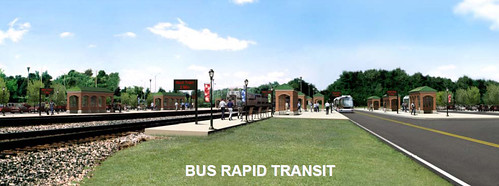
Metropolitan Grove station, showing MARC on the left.
Average Rating: 4.5 out of 5 based on 153 user reviews.
February 26th, 2013 | Permalink
Tags: architecture, BRT, funding, government, transportation

|
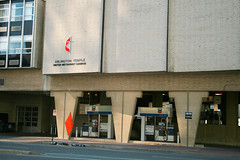
Photo by Joshua Davis. |
In response to Virginia Governor Bob McDonnell’s insane plan to fund transportation by eliminating the gas tax, Democrats in Virginia’s House of Delegates have proposed an alternative. It combines Democratic and Republican proposals to increase the gas tax statewide and give Northern Virginia separate authority to raise its own new funds.
Yesterday, the House Democratic Caucus outlined principles they believe should underlie any transportation funding plan for Virginia, and offered their support for a collection of 9 alternate bills which they say form a bipartisan path forward and an alternative to the governor’s plan.
Among those bills are Republican–written proposals to institute a new 5% fuel tax and to raise sales taxes in Northern Virginia specifically for transportation projects in that part of the state.
Any transportation plan, the House Democrats say, should:
- Generate at least $1 billion in new money per year.
- Rely on a realistic, dependable source of revenue, based on Virginia’s actions, not potential federal changes that may or may not happen.
- Not transfer monies that otherwise fund schools, health care, and public safety.
- Fund not just maintenance, but construction, including rail and transit.
- Provide additional revenue both immediately and into the future.
- Give authority to Northern Virginia and Hampton Roads to raise additional funds for their own transportation needs.
These are solid principles, and they offer a stark contrast to McDonnell’s plan. The governor’s proposal would raise far less, and relies on money from the general fund, as well as from a federal Internet sales tax that has not passed Congress.
The 9 specific bills that Democrats cited as true to those core principles are HB1677, HB1878, HB2063, HB2179, HB2253, HB2333, HB1450, HB1472, and HB1633. The House could pick one of those 9 to push, or it could try to amend one of them to combine the best provisions from all.
Republicans control the Virginia House, and the Senate is evenly split, so any plan will need GOP support to pass.
Although it’s true that some questionable highway projects would surely be built if Virginia ultimately adopts this transportation funding plan, this also offers far more support for transit and urban needs than the governor’s proposal, and it doesn’t include as many harmful, regressive policies. This is a far more reasonable outline.
 Cross-posted at Greater Greater Washington. Cross-posted at Greater Greater Washington.
Average Rating: 4.9 out of 5 based on 276 user reviews.
January 29th, 2013 | Permalink
Tags: funding, government, transportation

Besides the popular TIGER program, the US Department of Transportation has 12 other discretionary competitive grant programs. They’re all relatively small, generally awarding no more than a couple of million dollars to any given project. Yesterday USDOT announced its award winners for 2012, and the DC region hauled in a bunch of awards.
In total, the DC region got 13 grants totaling about $18.5 million. We won grants through 6 of the 12 programs, including multiple grants in two categories. Here’s the breakdown:
| Location |
Amount |
Description |
Public Lands Highway Discretionary Program
For any kind of transportation project within or providing access to federal lands or facilities. |
| DC |
$6, 042, 000 |
American Veterans Disabled for Life Memorial
This project will reconfigure a roadway, including utility work, signage, lighting, pavement markings and improved pedestrian facilities, to make possible the construction of the American Veterans Disabled for Life Memorial near the U.S. Capitol. |
| MD |
$2, 060, 000 |
Chesapeake & Delaware (C&D) Canal Recreational Trail
This project will complete the western 1.8 miles of the recreational trail linking Chesapeake with the Delaware River. The existing gravel service road on the north side of the C&D Canal will be transformed into a multi-purpose recreation trail with signage, operations and maintenance activities. |
| VA |
$496, 000 |
Design for Army Navy Drive Complete Street
This project will design upgrades for Army Navy Drive, the key arterial street between the Pentagon, I-395, and the Pentagon City / Crystal City transit-operations. Designed to funnel automobiles on and off I-395, the existing streets are extremely inhospitable to pedestrians, bicyclists, and transit users coming from or going to the Pentagon.
|
| VA |
$1, 000, 000 |
Route 1/Fuller Heights Road and Fuller Road Relocation
This project will realign and improve the intersection of Route 1 with Fuller Heights and Fuller Roads to create safe and secure access to the main gate of Marine Corps Base Quantico. |
Transportation, Community and System Preservation Program
Promote coordination among transportation, community, and system preservation. Funds to improve efficiency, reduce environmental impacts, and improve access to jobs, services, and centers of trade. |
| DC |
$1, 000, 000 |
Kennedy Street Revitalization
TCSP funds will help upgrade streetlights and sidewalks on Kennedy Street and improve safety at key intersections. |
| Regional |
$160, 000 |
High Impact Complete Streets Access Improvements for Rail Station Areas in the Washington Region
TCSP funds will be used to plan for improved bicycle and pedestrian access improvements near rail stations in the Washington, DC area to support housing and employment development. |
| MD |
$827, 200 |
Complete Streets Near Metro Stations
TCSP funds will help improve pedestrian safety with crosswalks on public roadways near the Twinbrook Metro station and provide space on South Stonestreet Avenue near the Rockville Metro station for bike lanes and a sidewalk. |
| MD |
$1, 000, 000 |
Maryland Route 5 at Brandywine Road and Maryland Route 373 Intersection Relocation Phases 2-3
TCSP funds will help acquire a portion of the right-of-way needed to widen about 4, 000 feet of road, replace existing signalized intersections at Brandywine Road and MD 373 with a new interchange, and provide a park-and-ride lot for commuters. |
| VA |
$800, 000 |
Walk to Downtown Vienna Initiative
TCSP funds will improve local pedestrian safety by constructing sidewalks on side streets in downtown Vienna and improve access from neighborhoods to local stores and merchants. |
Highways for LIFE Pilot Program
Uses innovative technologies and practices to more quickly construct safe and efficient highways and bridges with longer life spans. |
| VA |
$1, 320, 000 |
Staffordboro Blvd. Park and Ride Access in Stafford County
This project will use roller compacted concrete, which allows for immediate opening to traffic and is durable against heavy loads, in the construction of the Staffordboro Park and Ride Expansion project. |
National Scenic Byways Program
Funding supports projects that manage and protect these roads recognized as having outstanding scenic, historic, cultural, natural, recreational, and archaeological qualities. |
| MD |
$55, 120 |
Star Spangled Banner Byway Signage
This project will install a signage system along the Battle-of-Bladensburg portion of the Star-Spangled Banner National Historic Trail and Byway. |
Truck Parking Facilities Program
For improvements related to commercial motor vehicle parking. |
| MD |
$2, 623, 993 |
New Truck Parking Spaces in Howard County
This project will construct 40 new truck parking spaces at the southbound welcome center on I-95 in Howard County to address a severe shortage of commercial vehicle parking along this portion of the I-95 corridor. |
Value Pricing Pilot Program
Supports projects that manage congestion on roads via pricing strategies, including congestion tolling, mileage-based car insurance, parking pricing, and others. |
| DC |
$1, 090, 000 |
Multimodal, dynamic parking pricing in downtown Washington, DC
This project will implement dynamic pricing and a reservation system for commercial vehicle parking to manage metered curb-side spaces in the congested downtown business district and tourist areas. It will encourage freight travel at off-peak times and enable tour bus operators to find parking, as well as use parking revenues to support transit services. |
Average Rating: 5 out of 5 based on 161 user reviews.
August 3rd, 2012 | Permalink
Tags: funding, government, transportation

|
Media





Site
About BeyondDC
Archive 2003-06
Contact
Category Tags:
Partners
|




 Comment on this at the version cross-posted to Greater Greater Washington.
Comment on this at the version cross-posted to Greater Greater Washington.






















